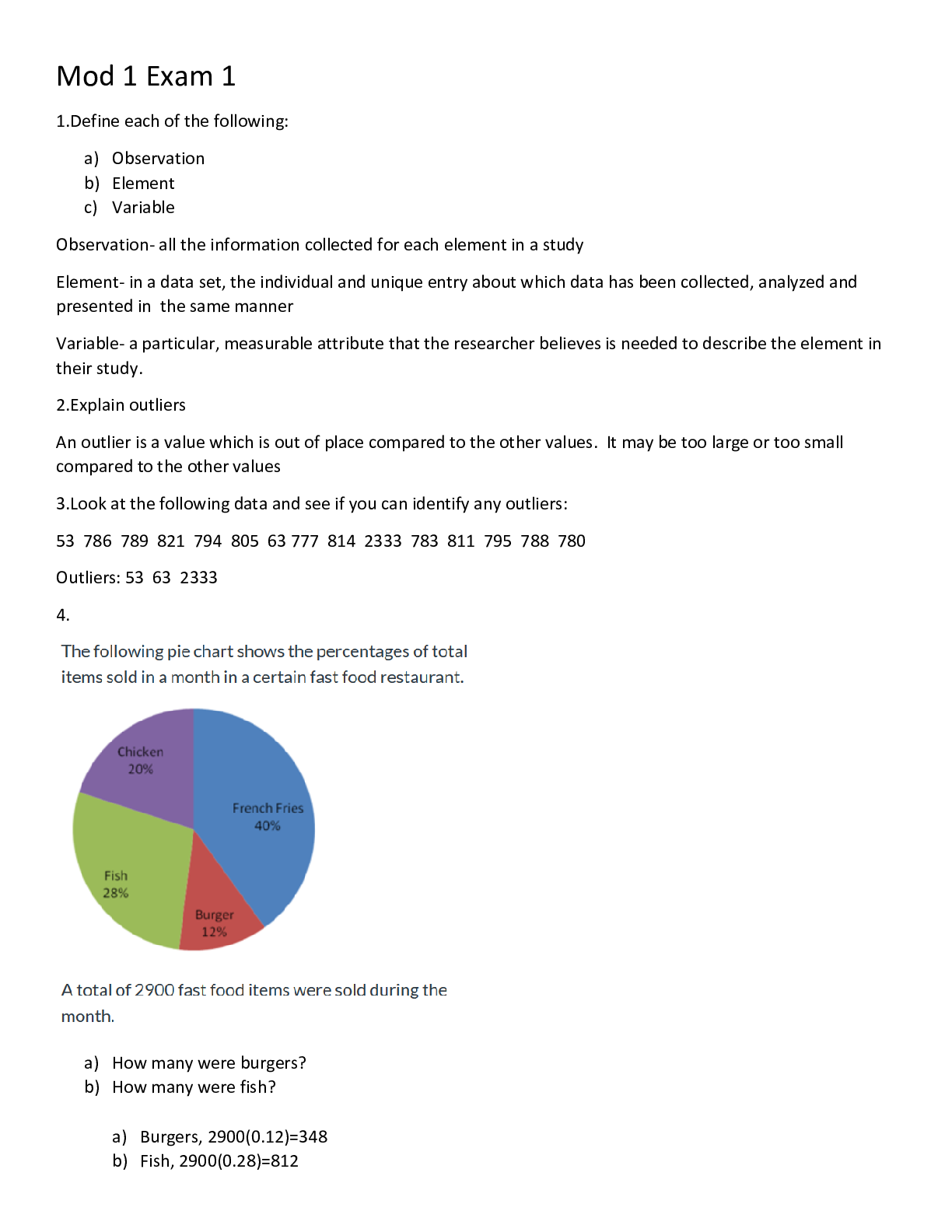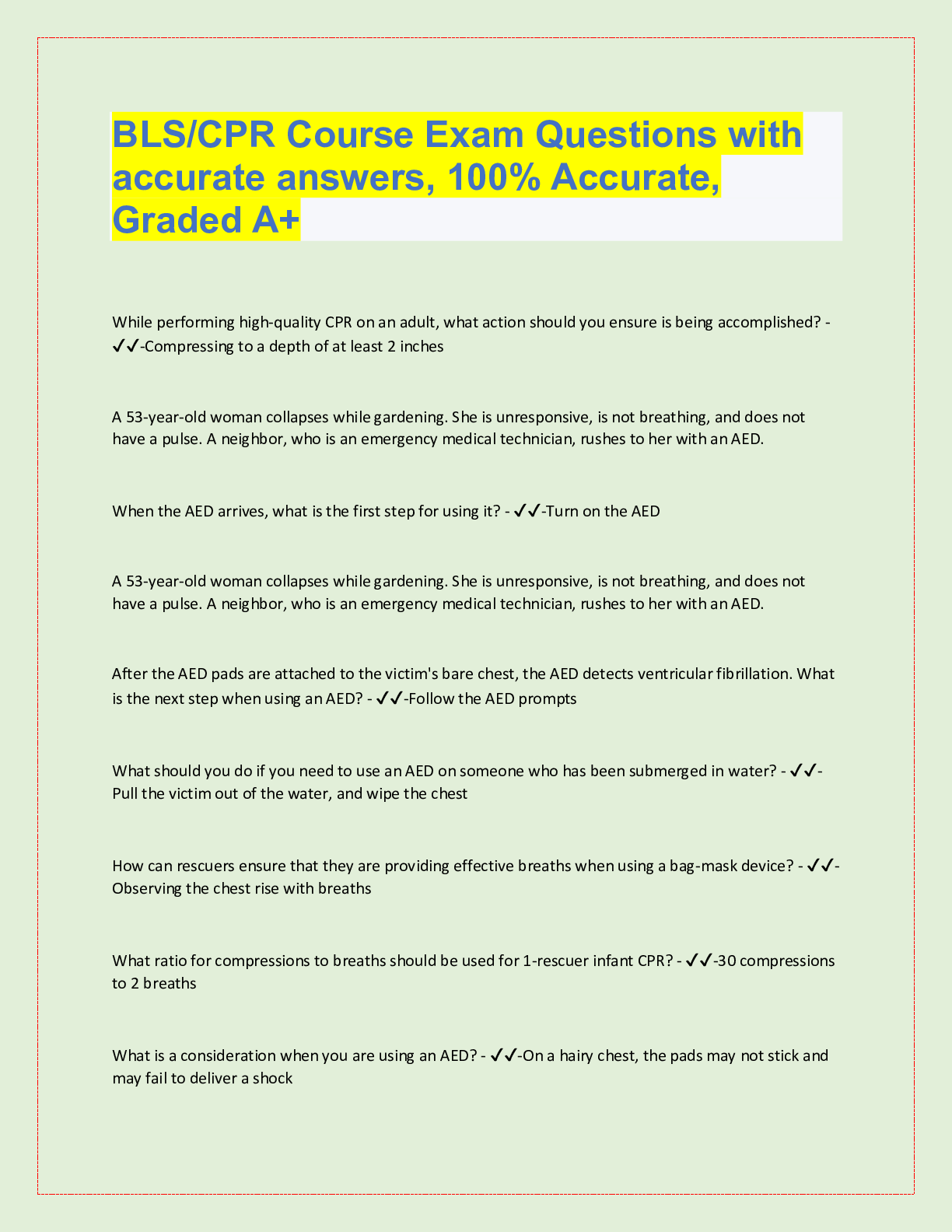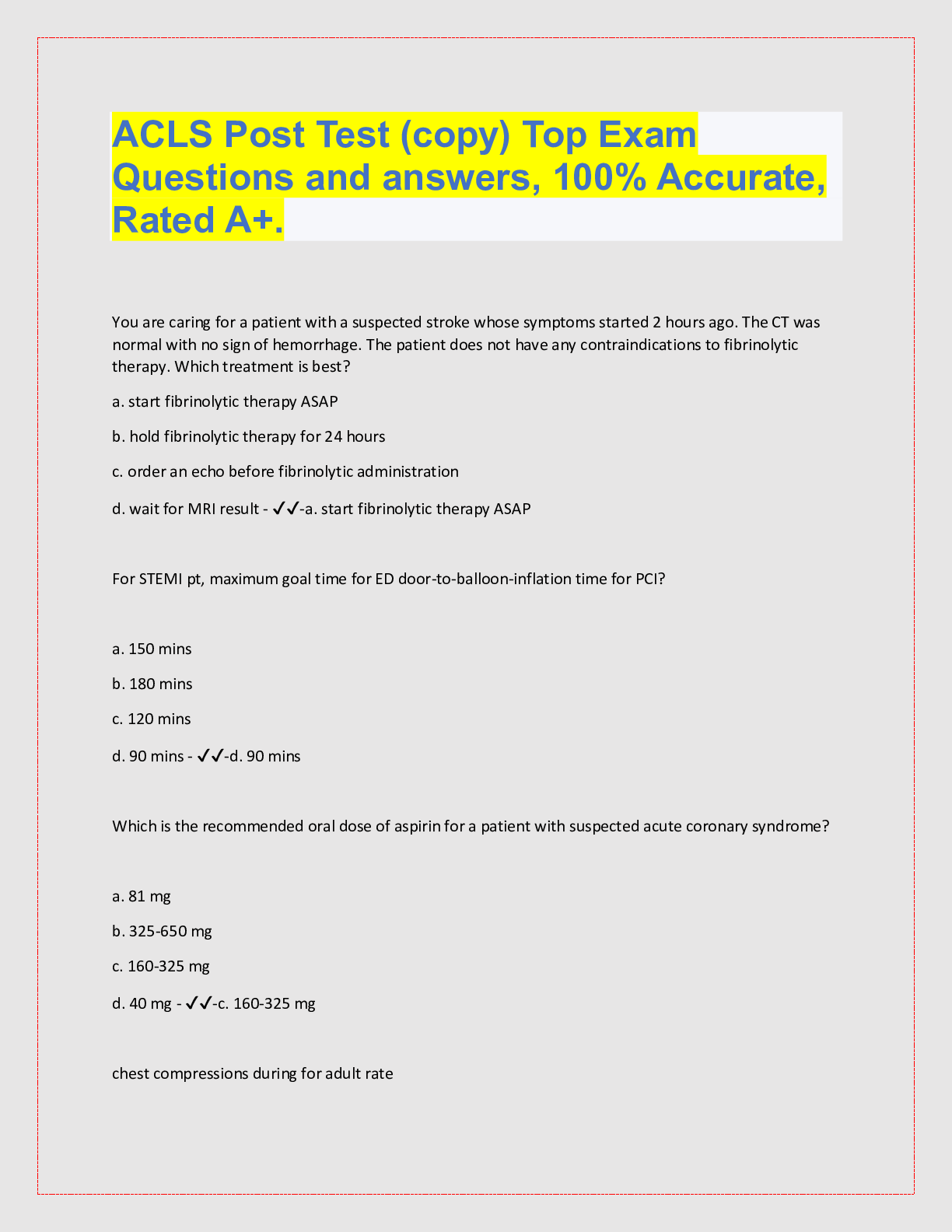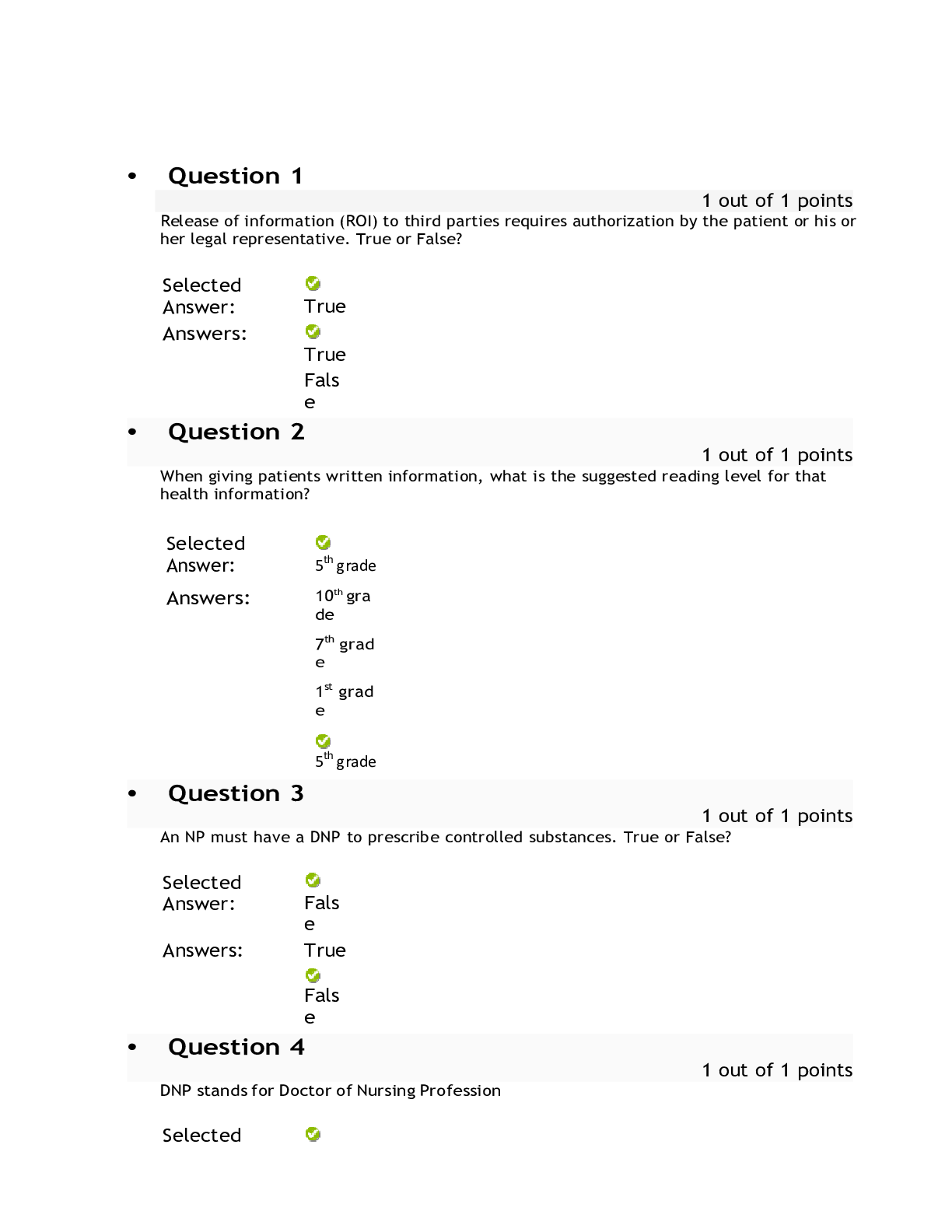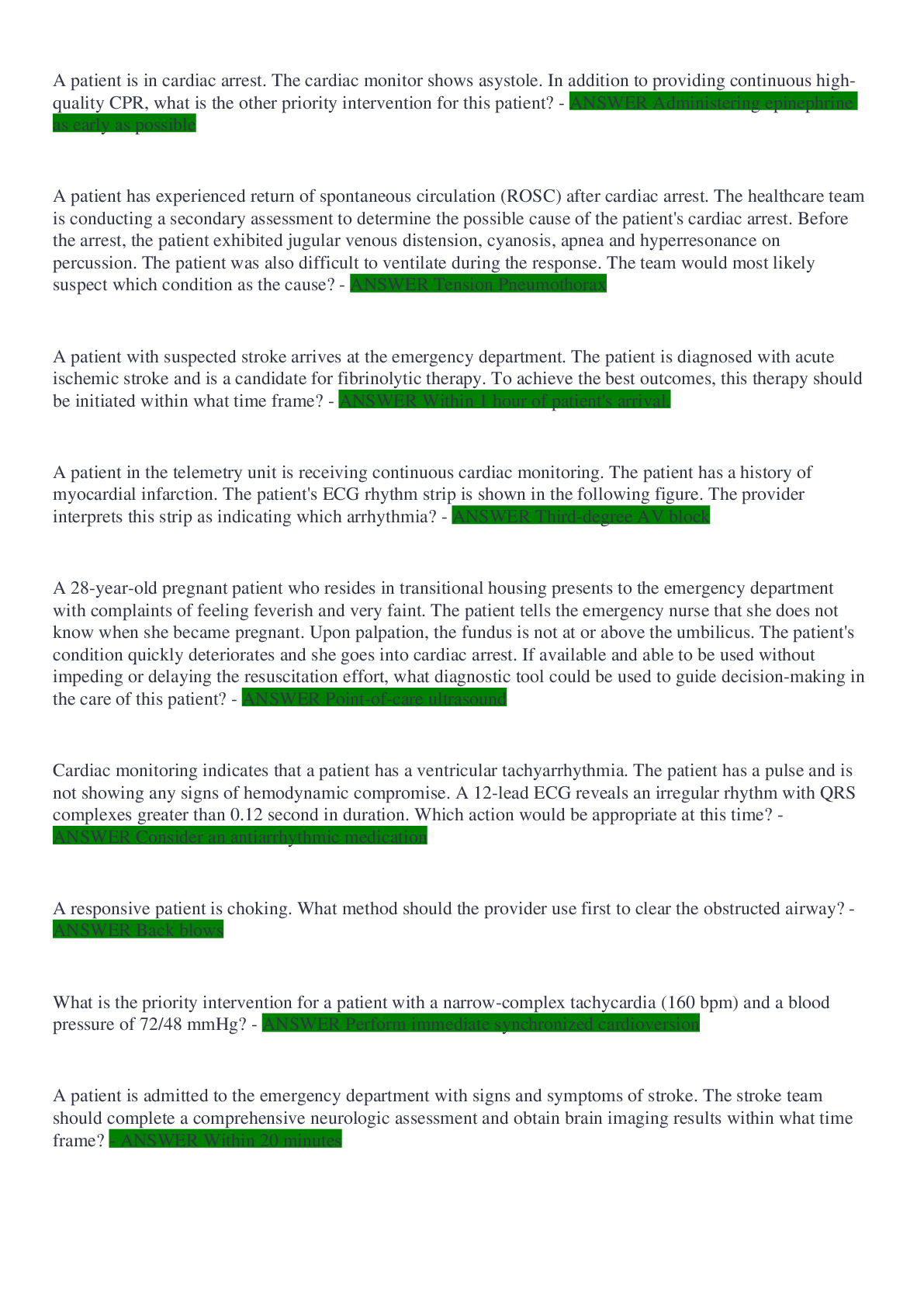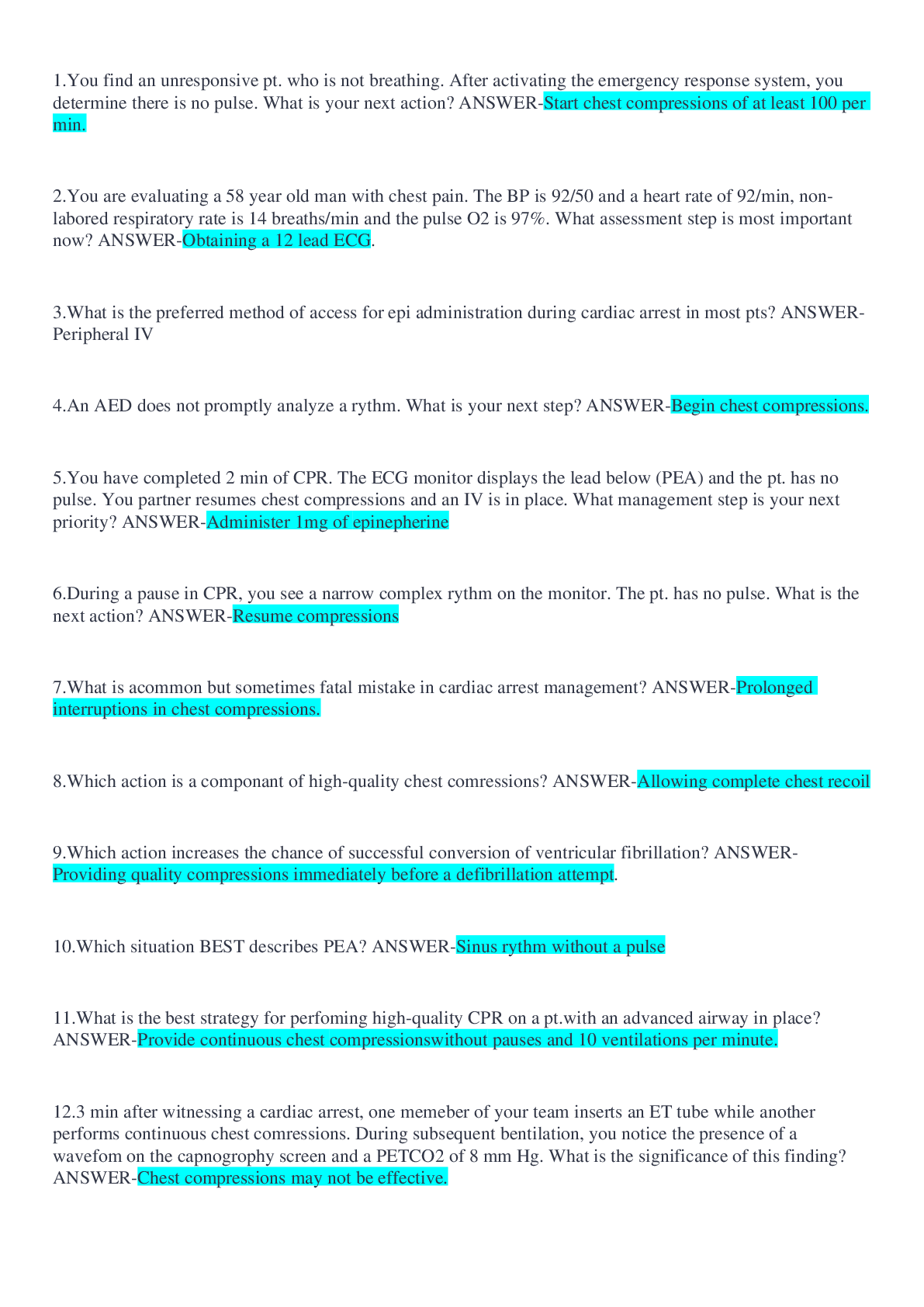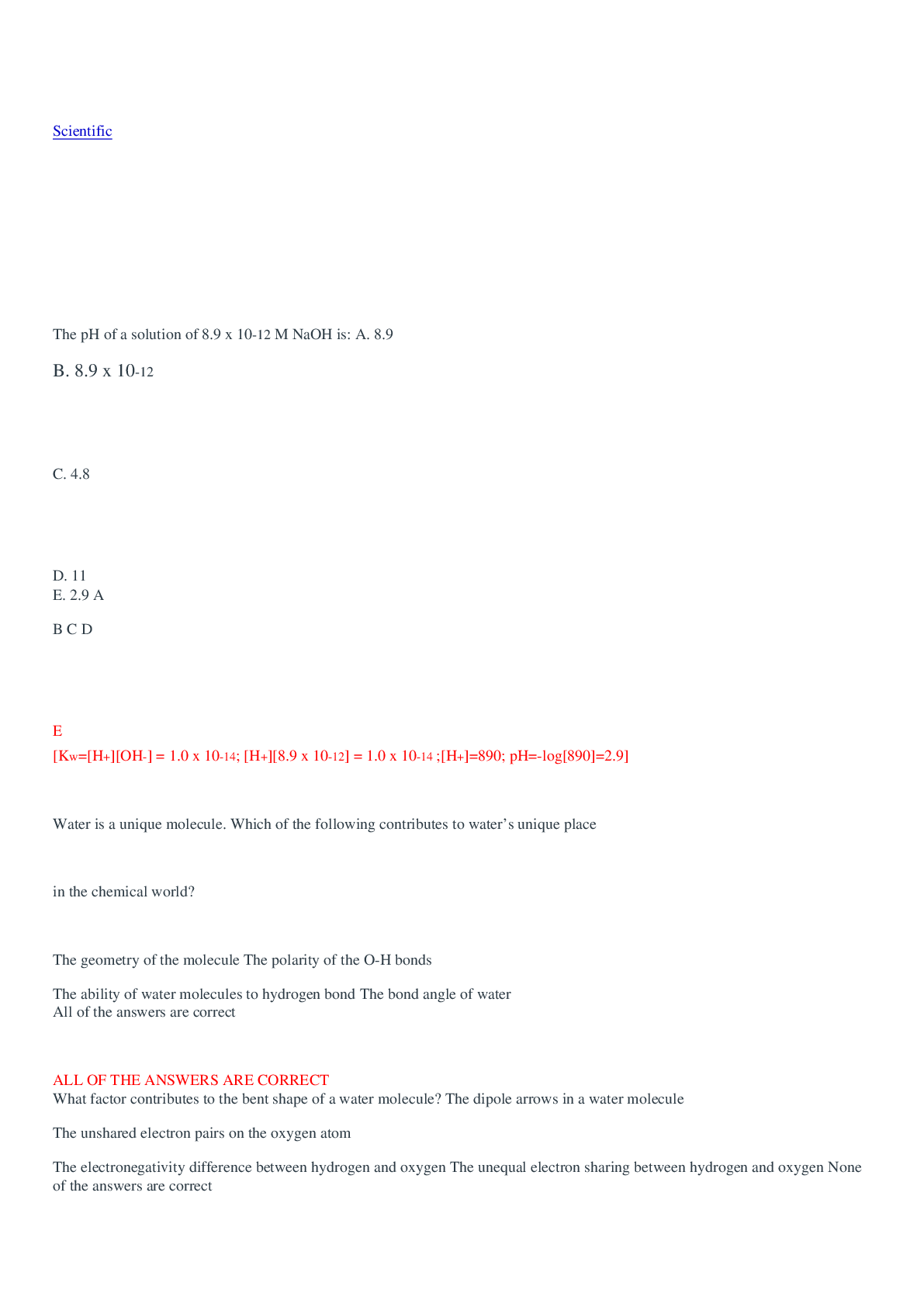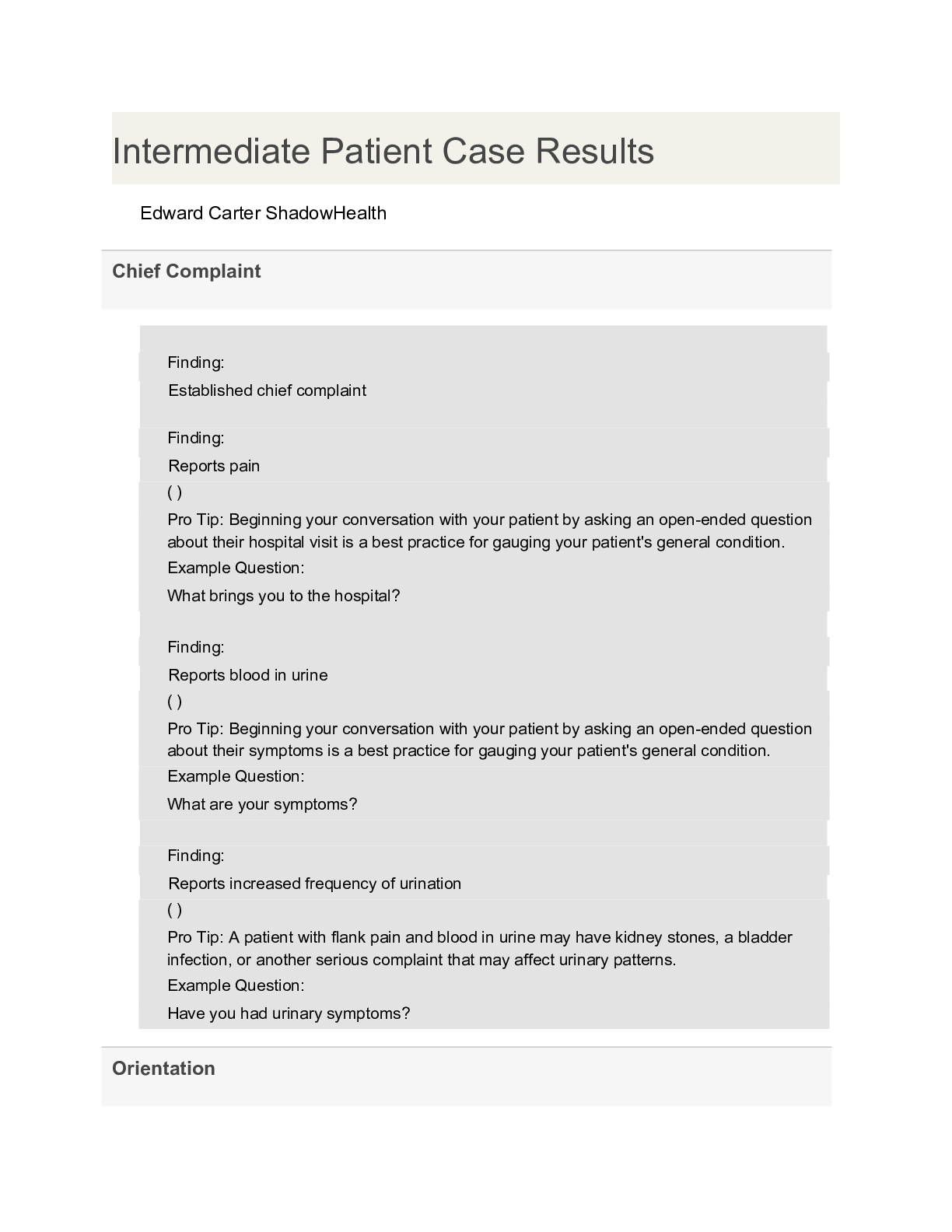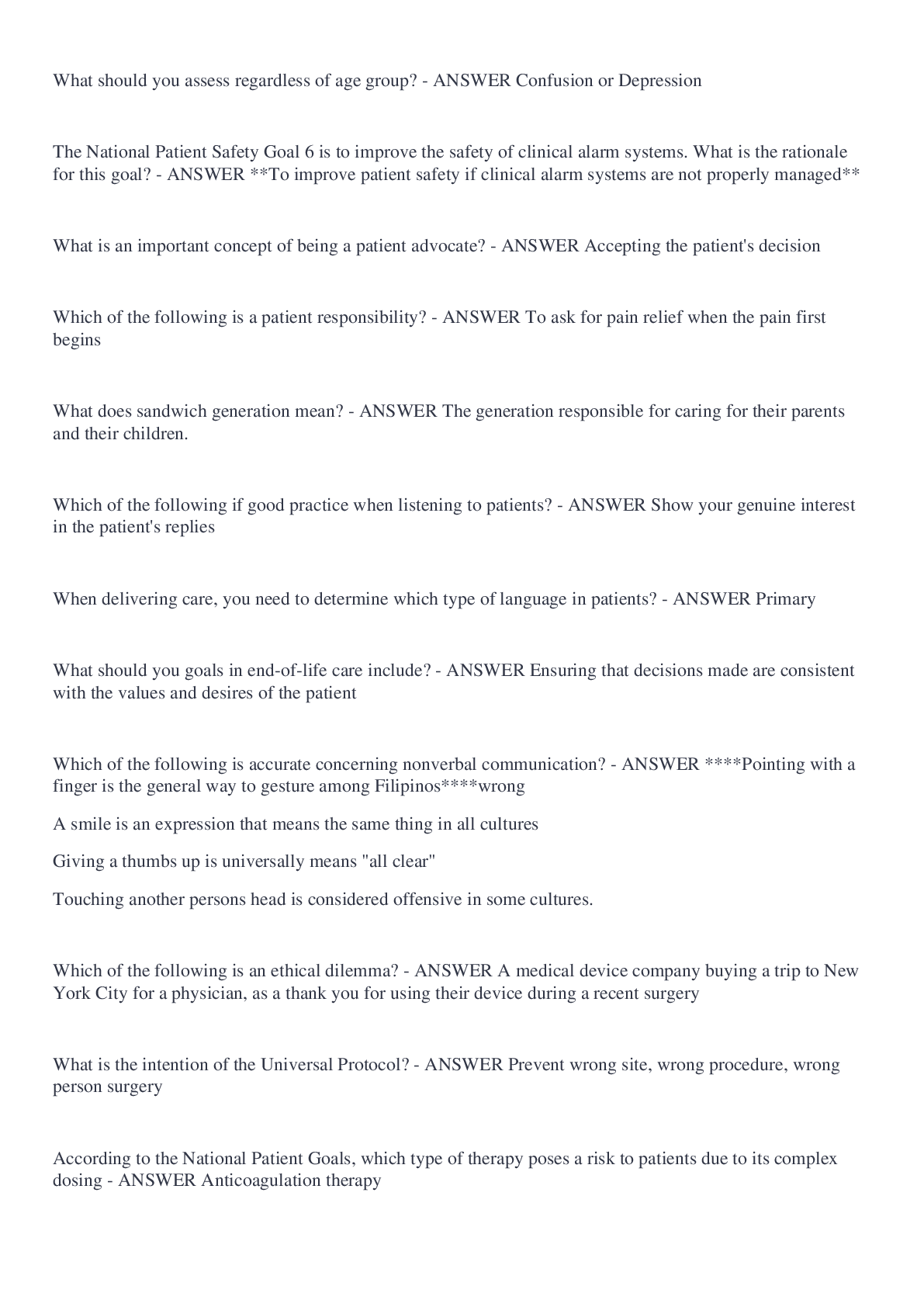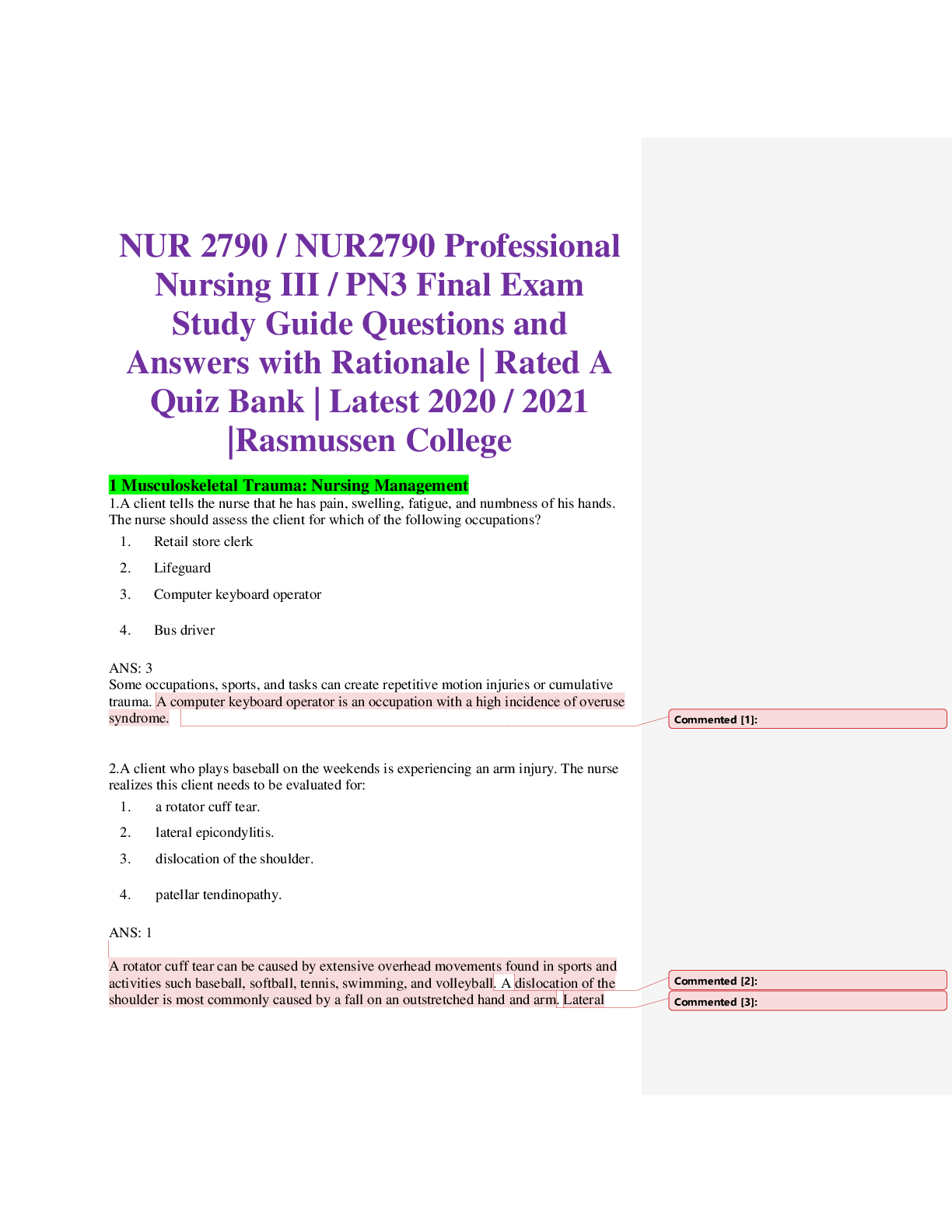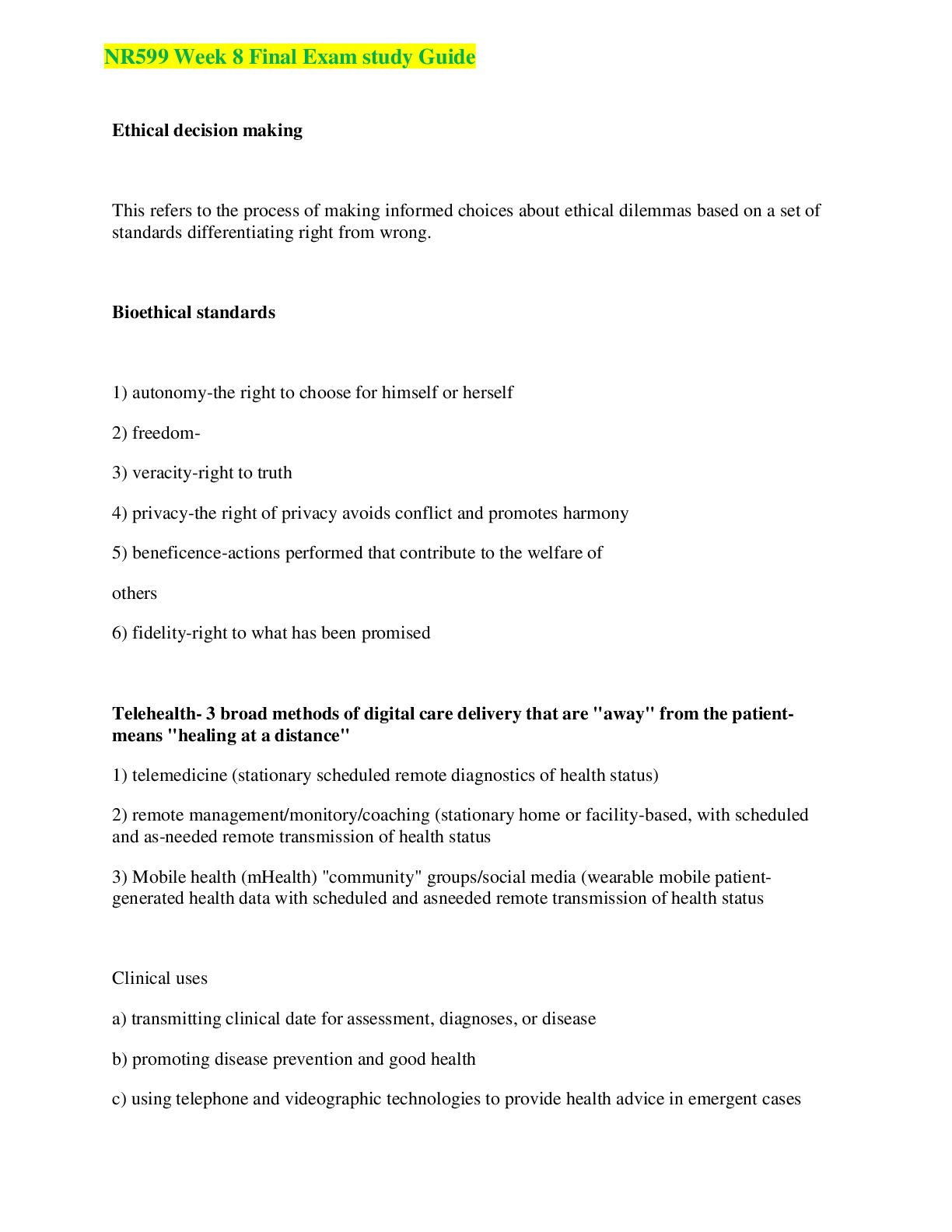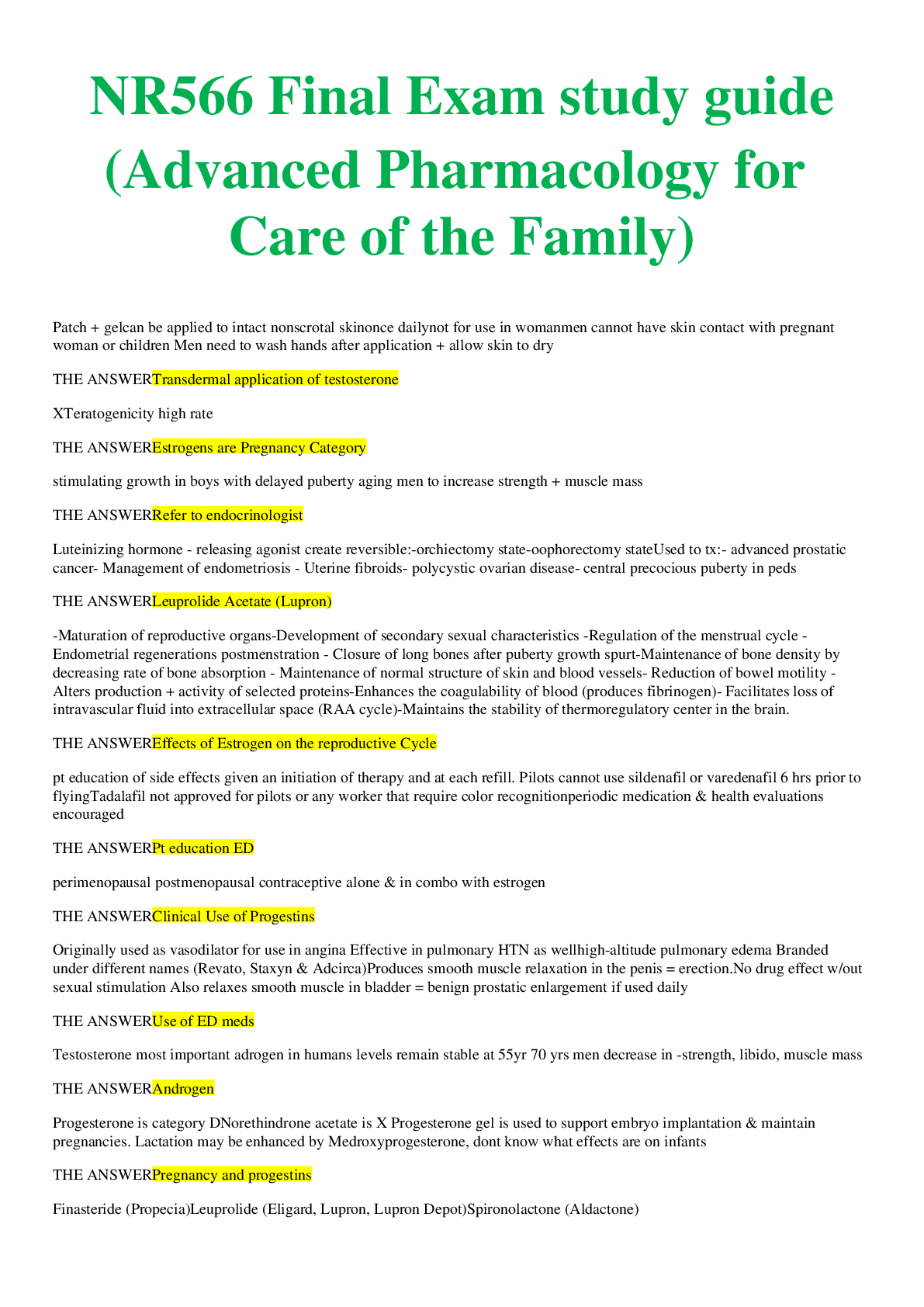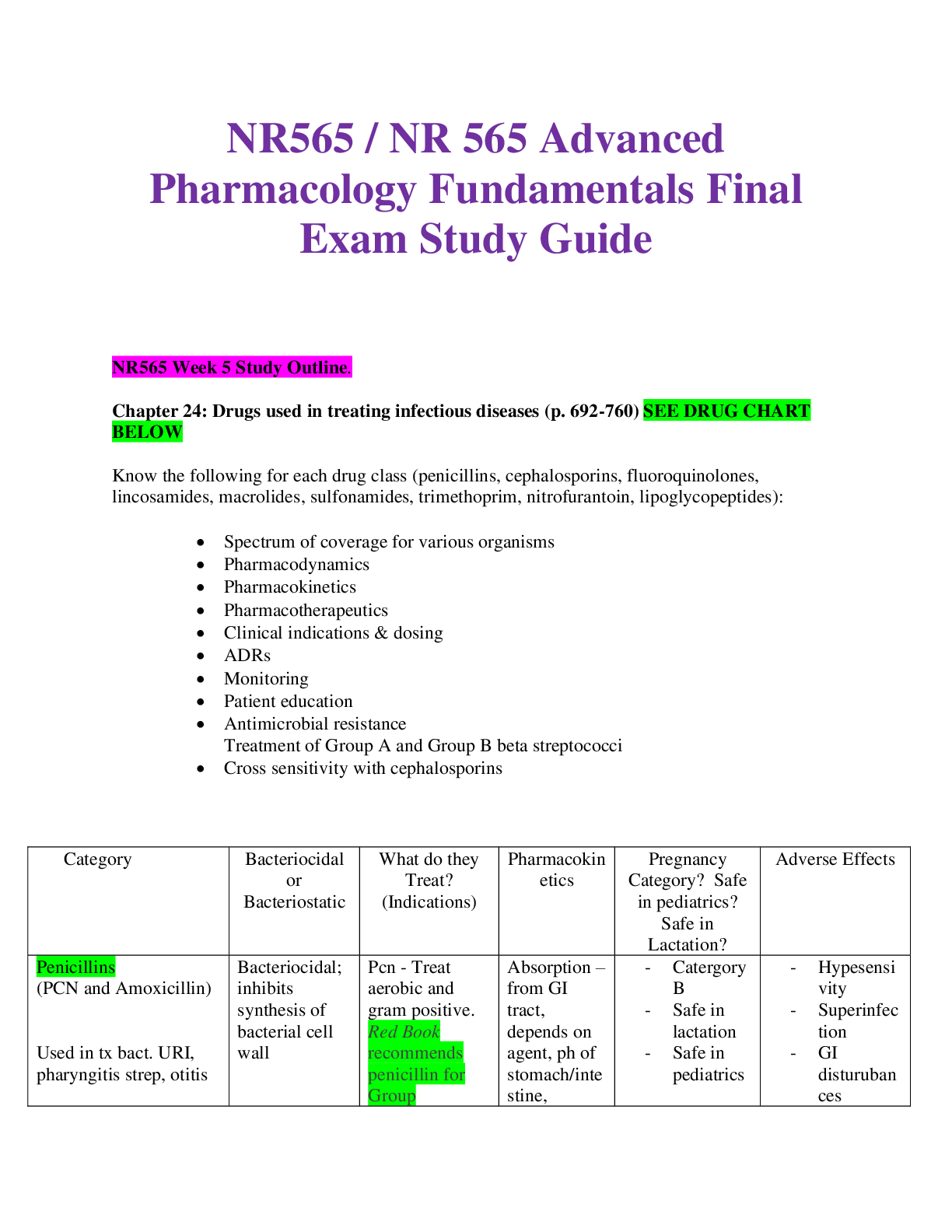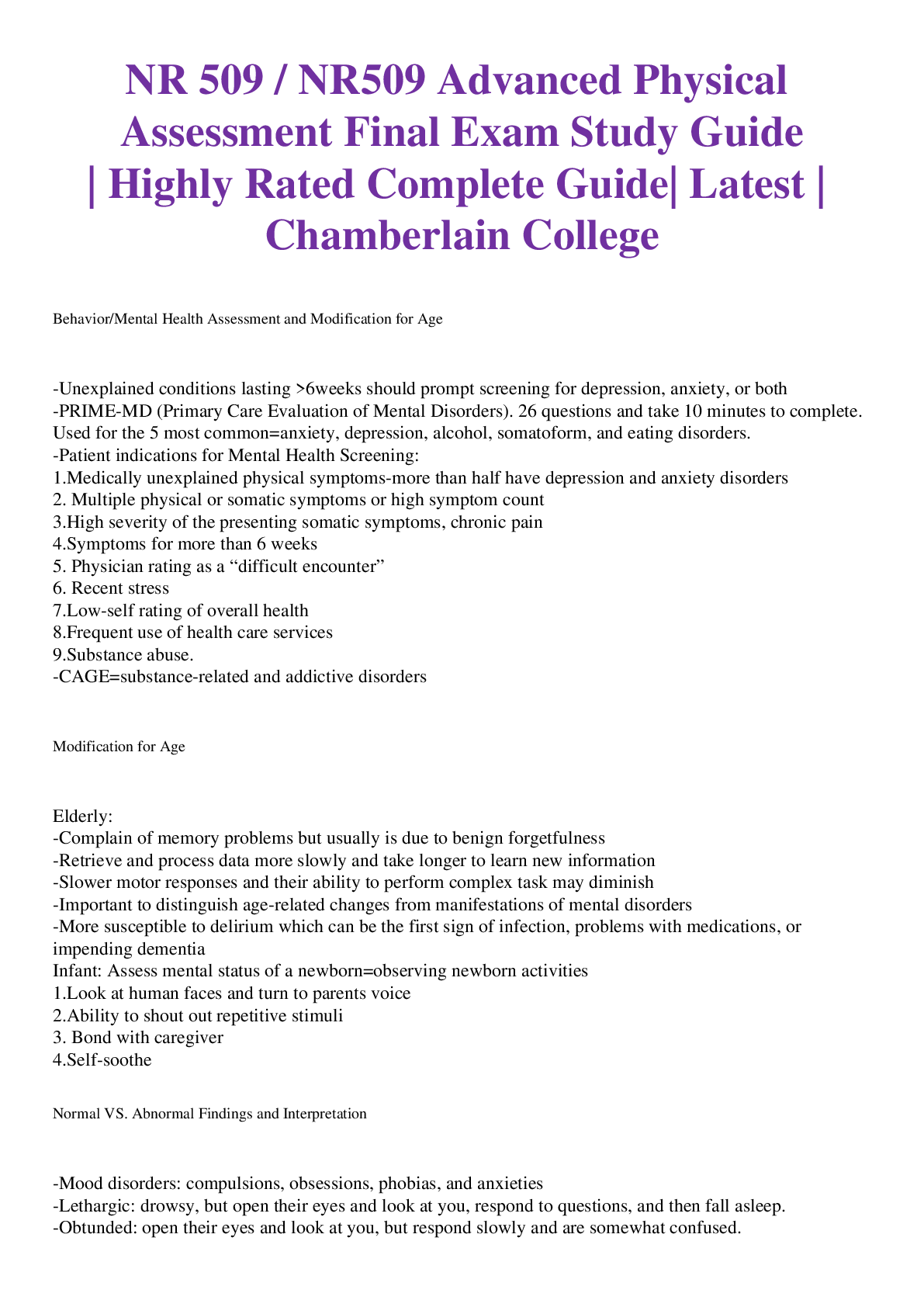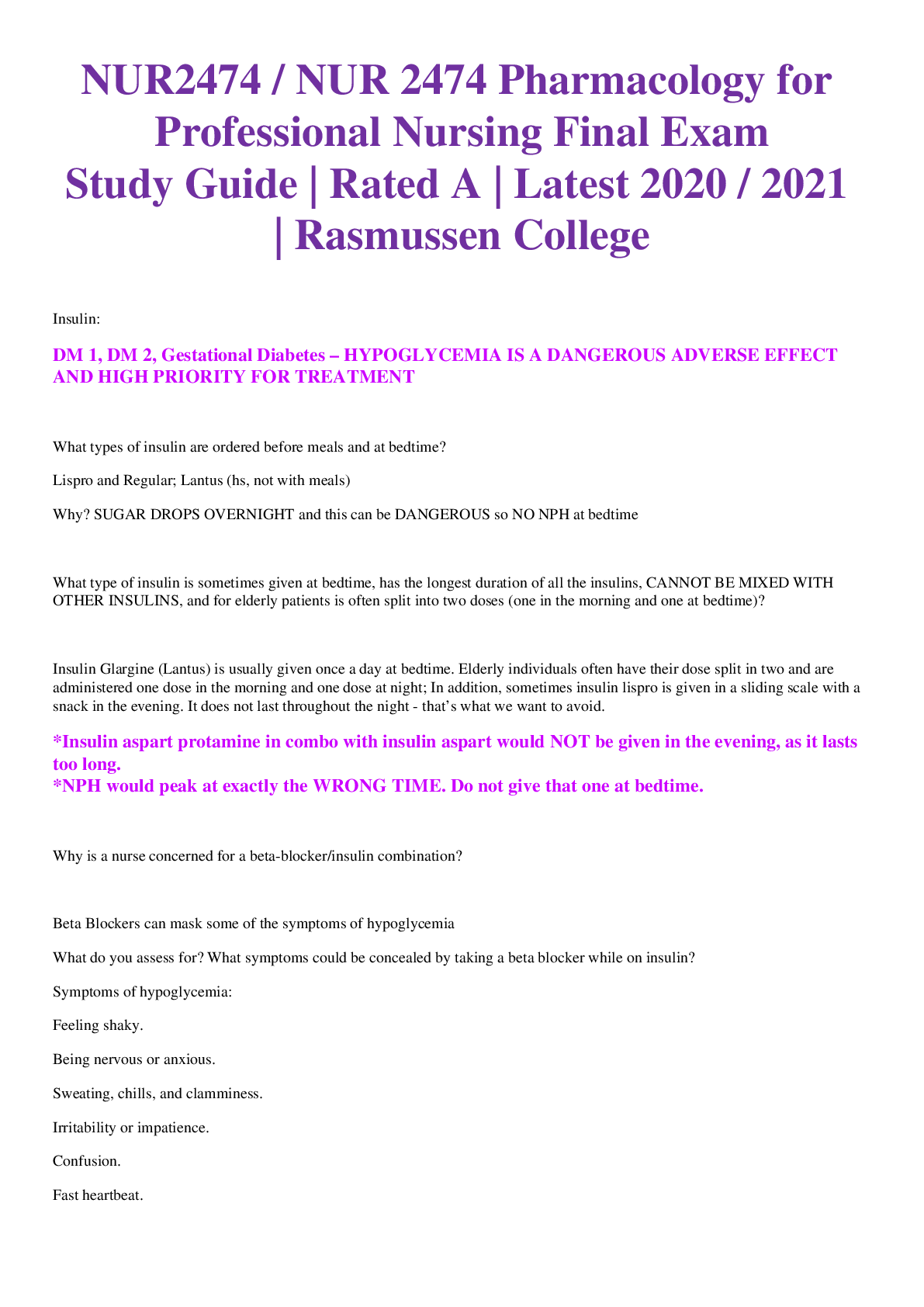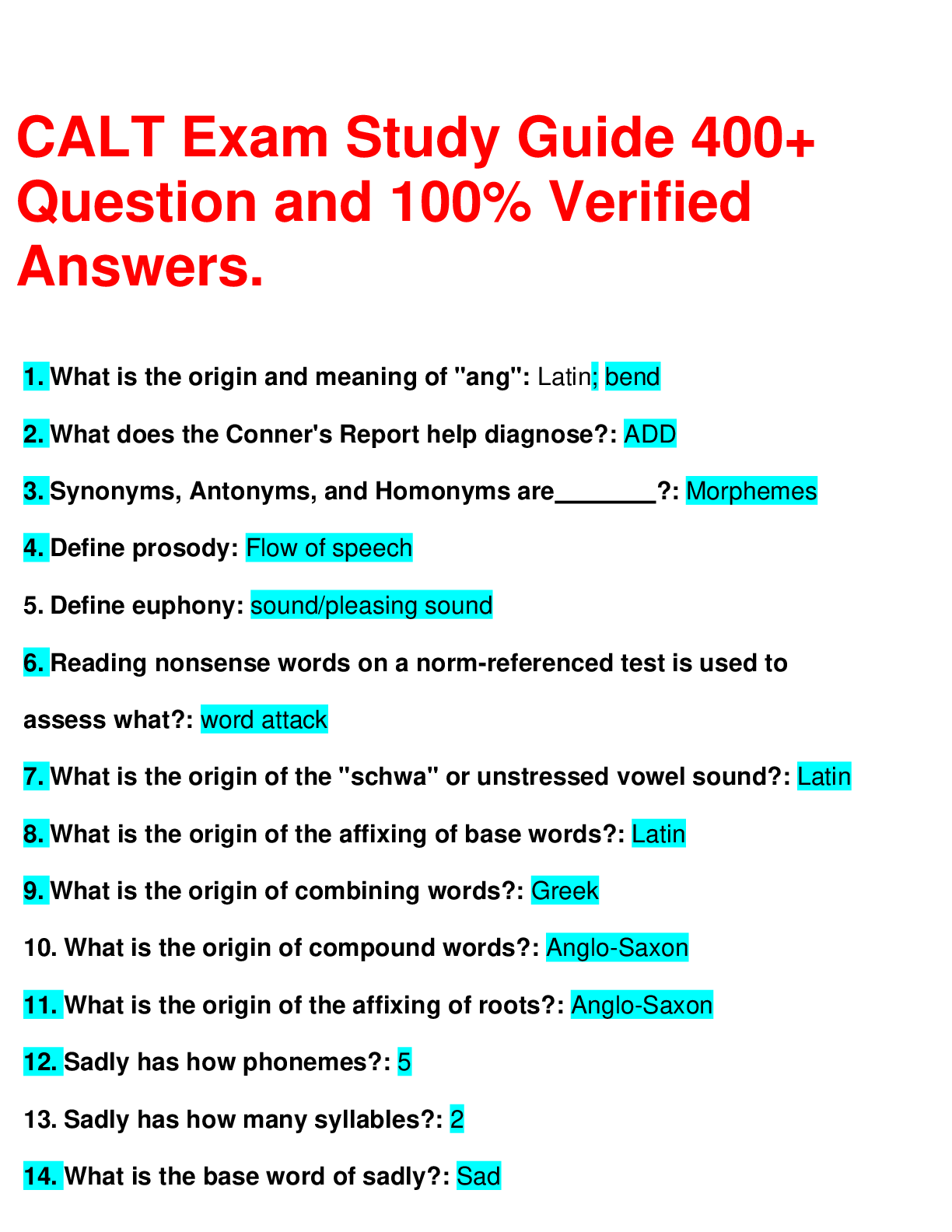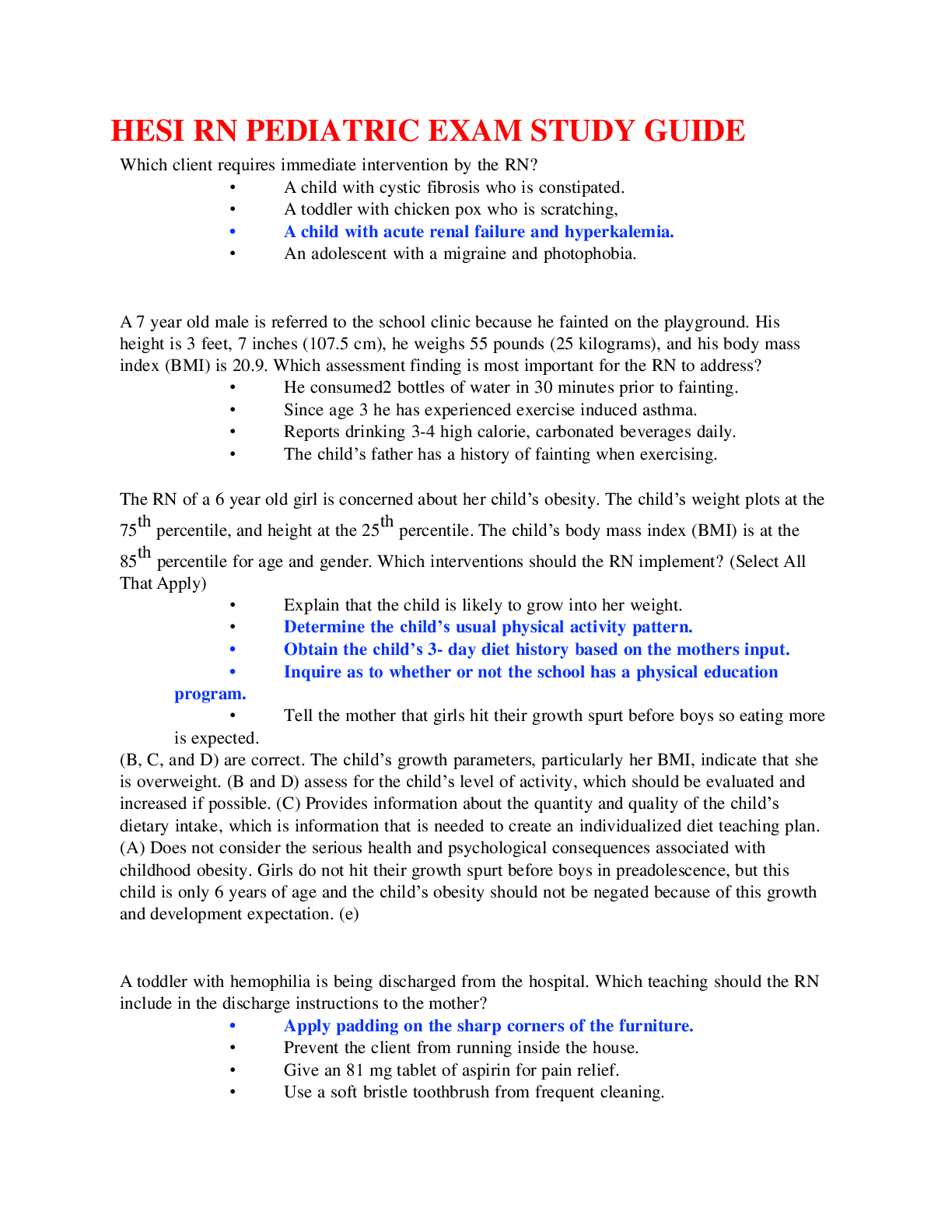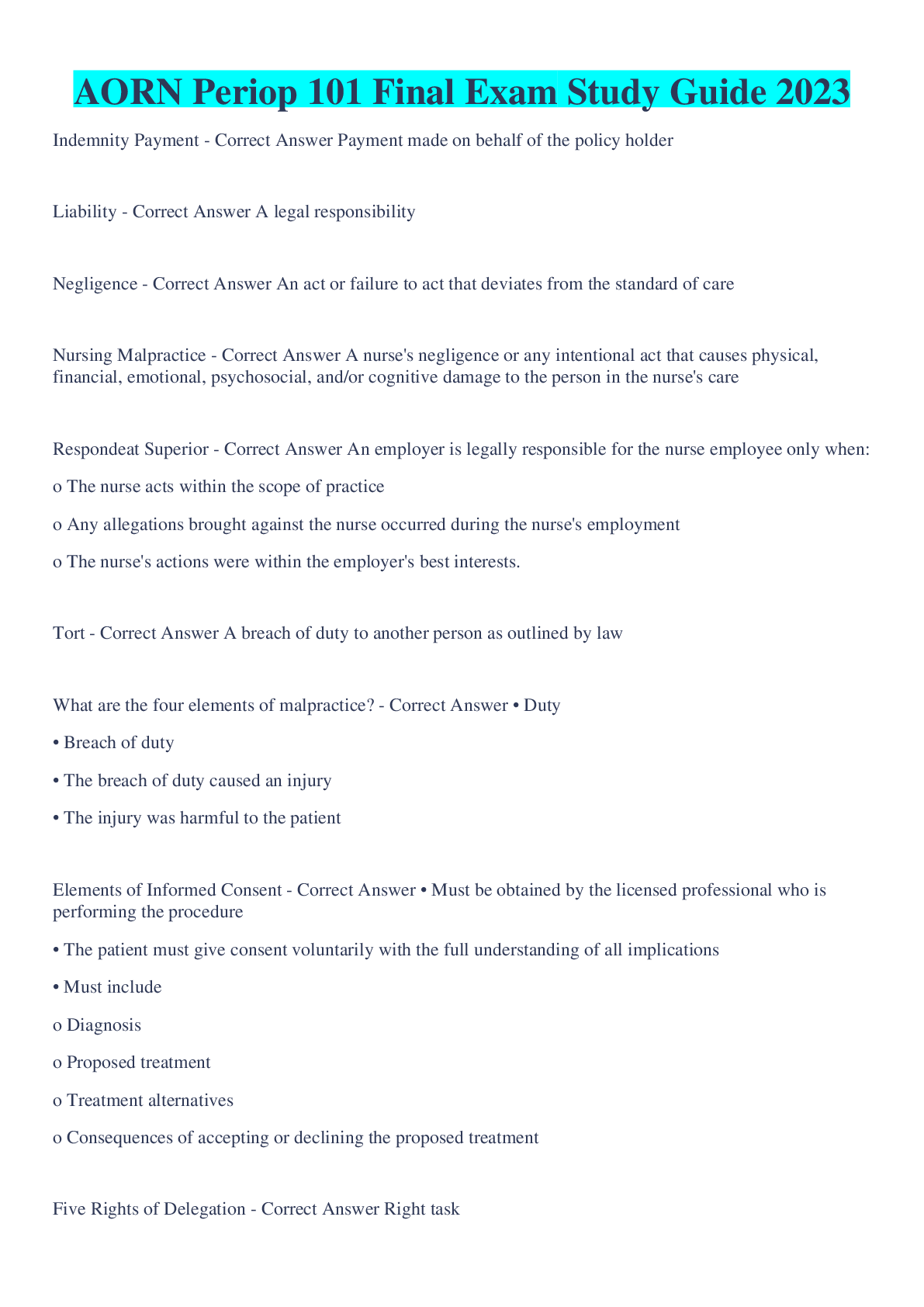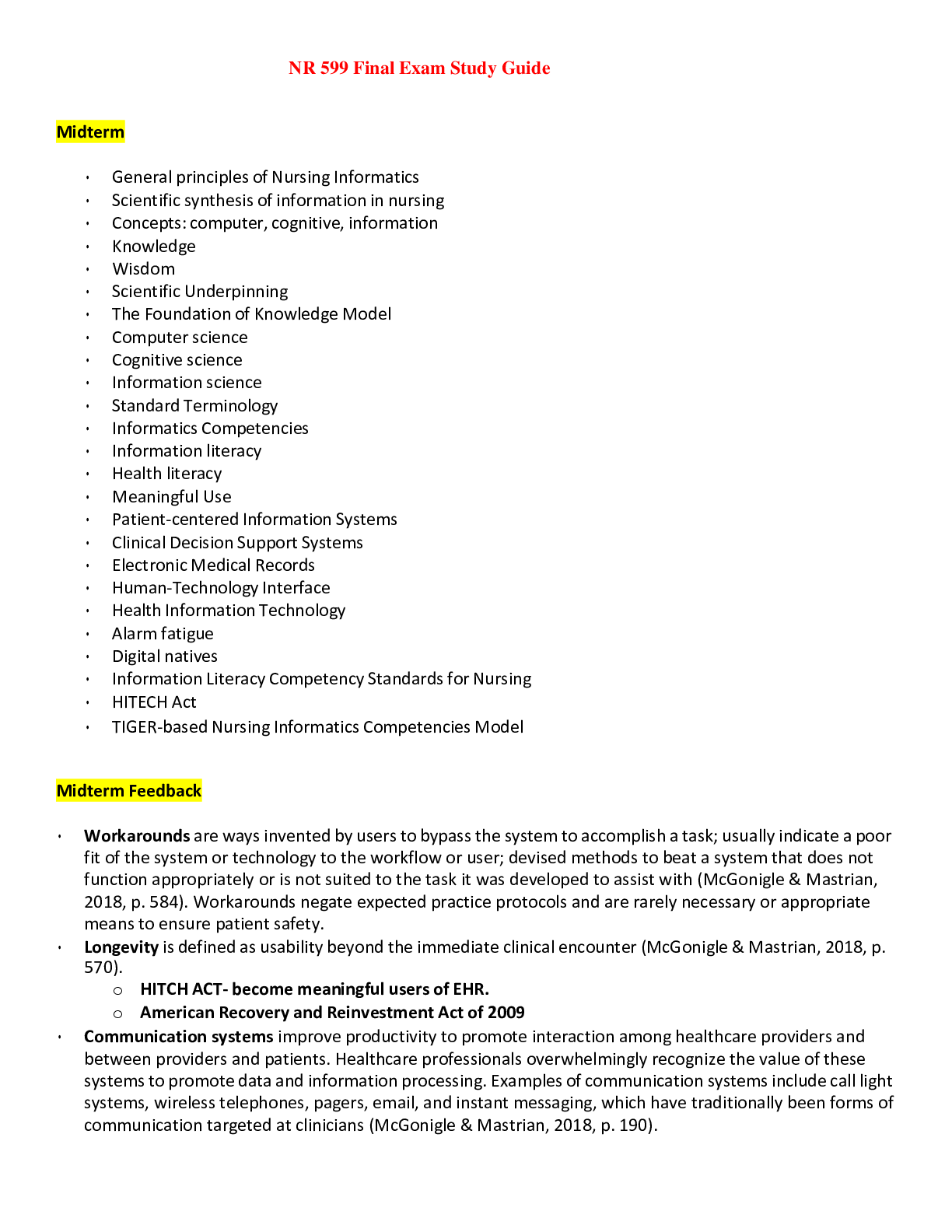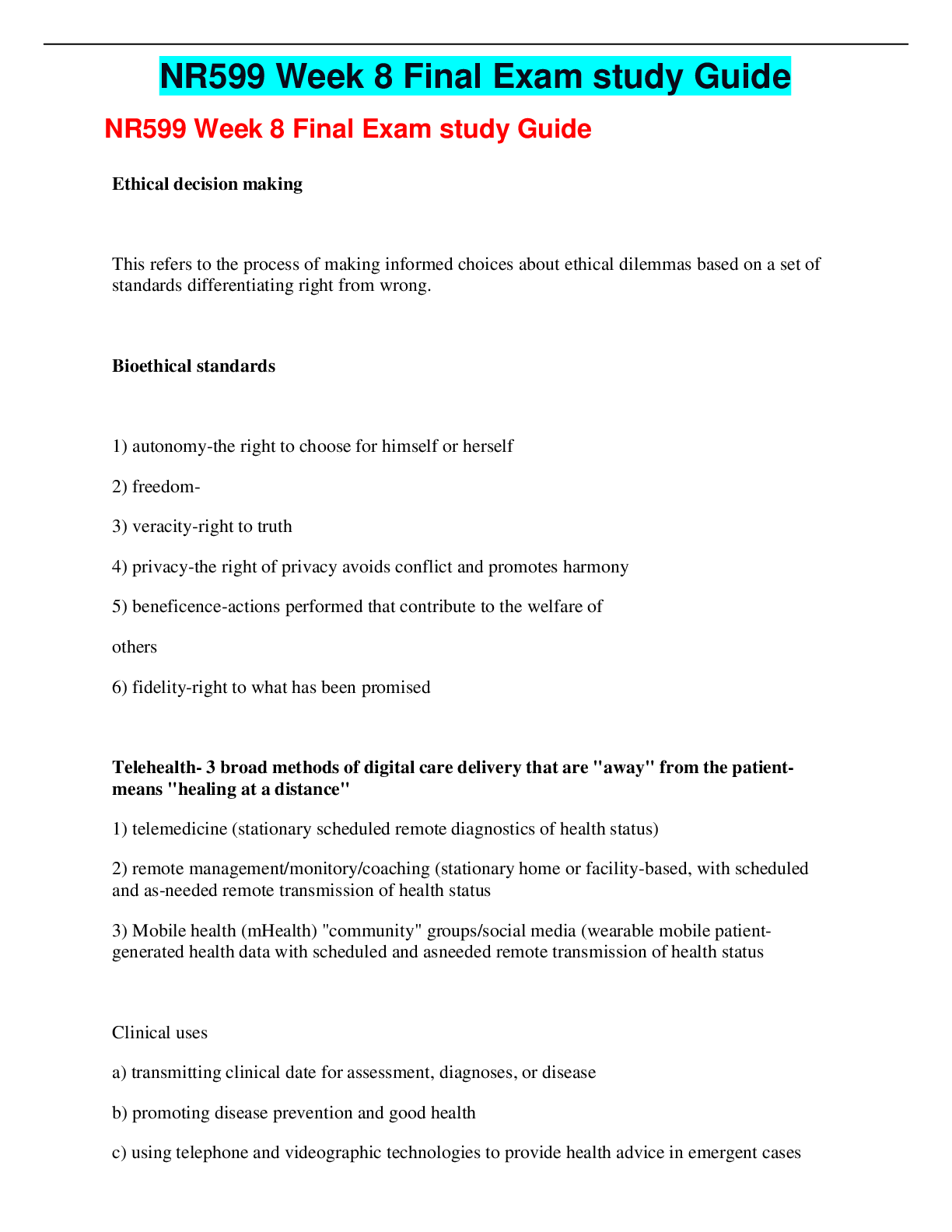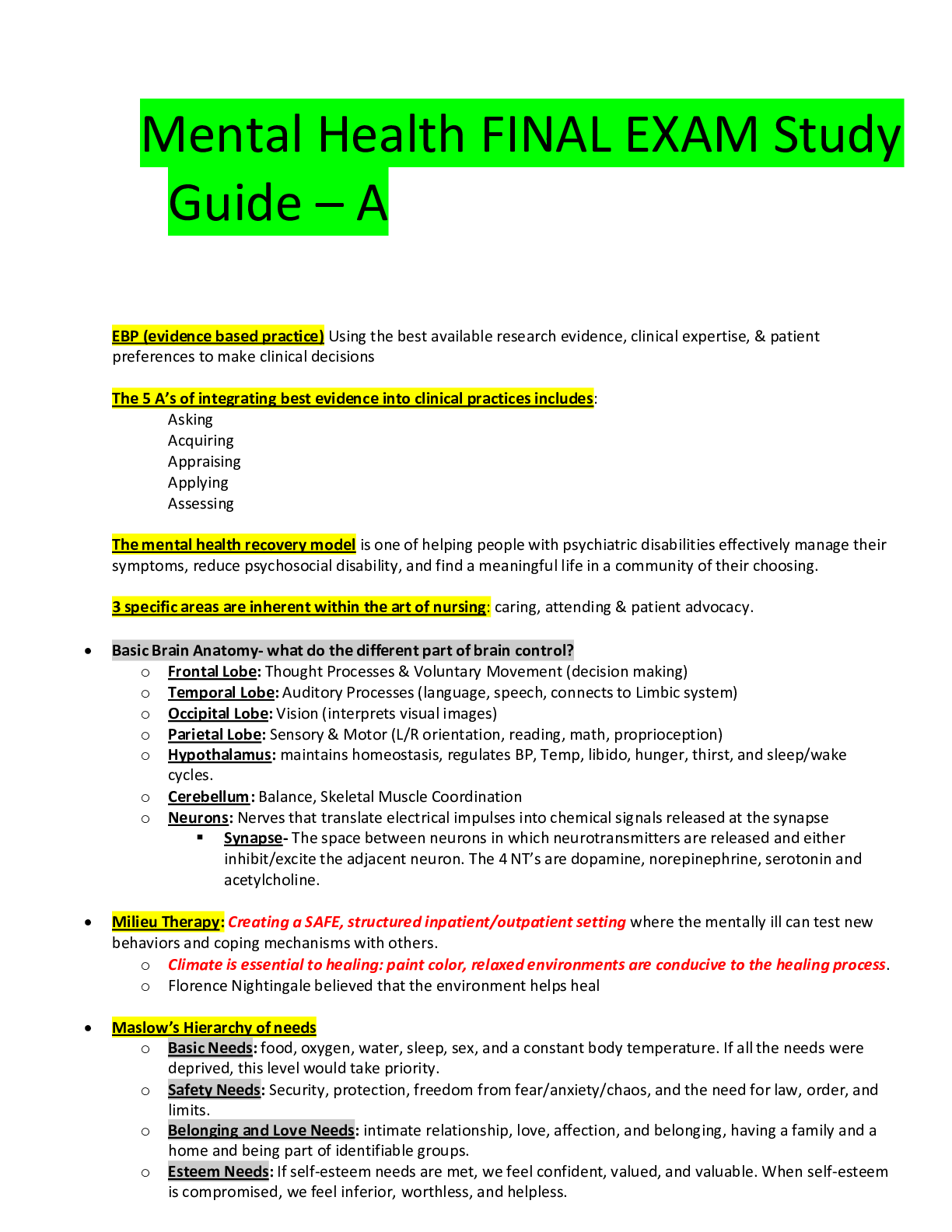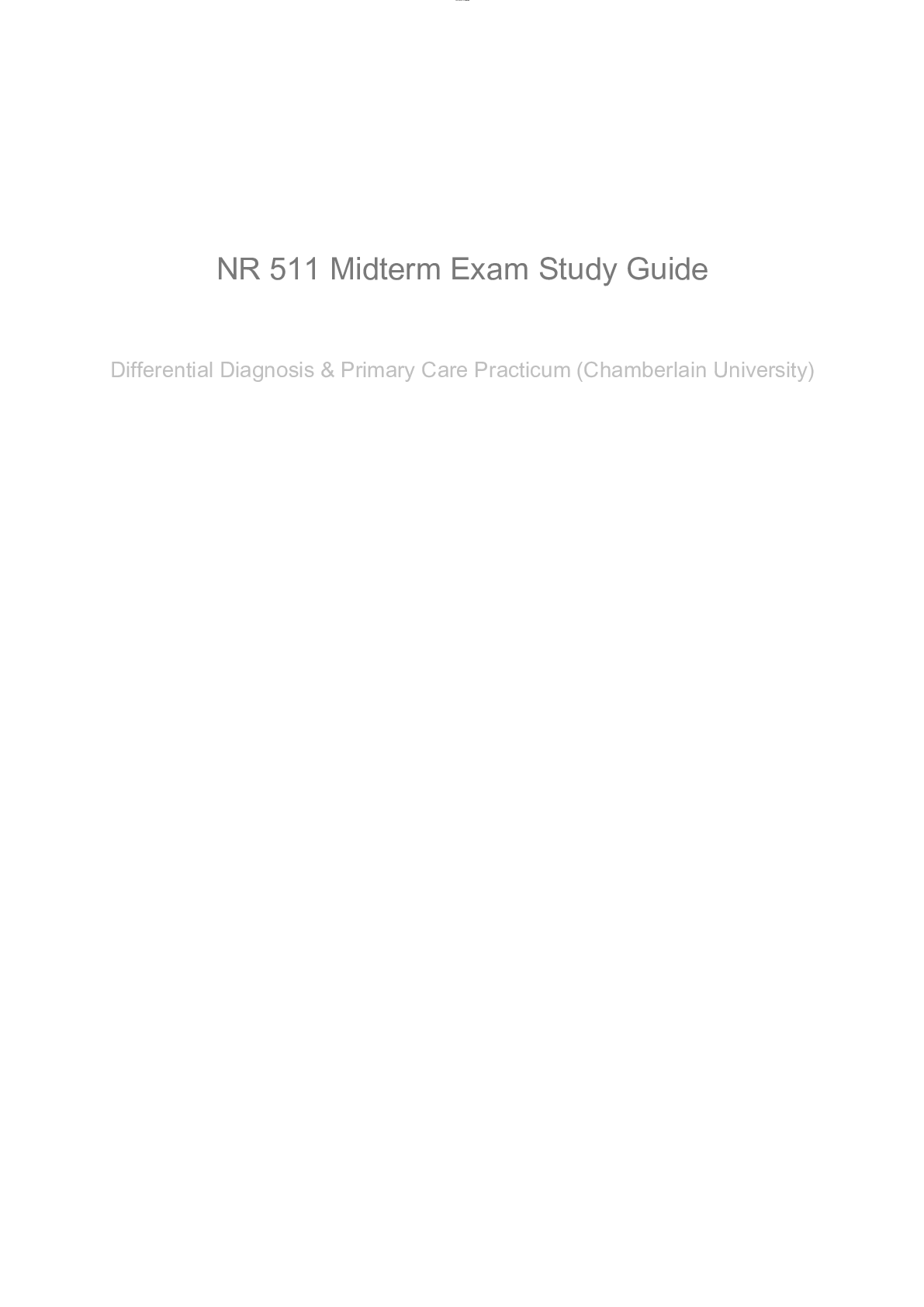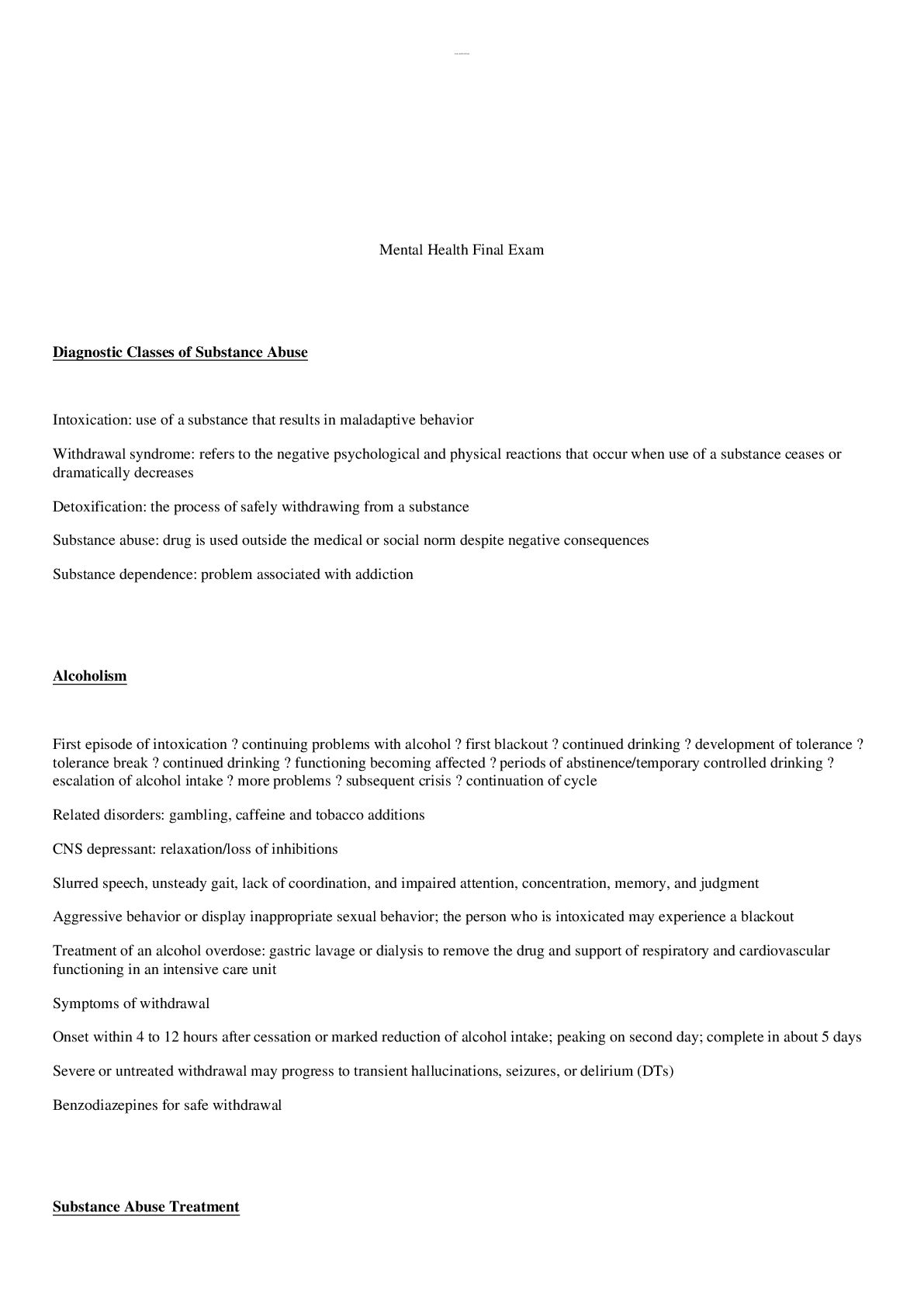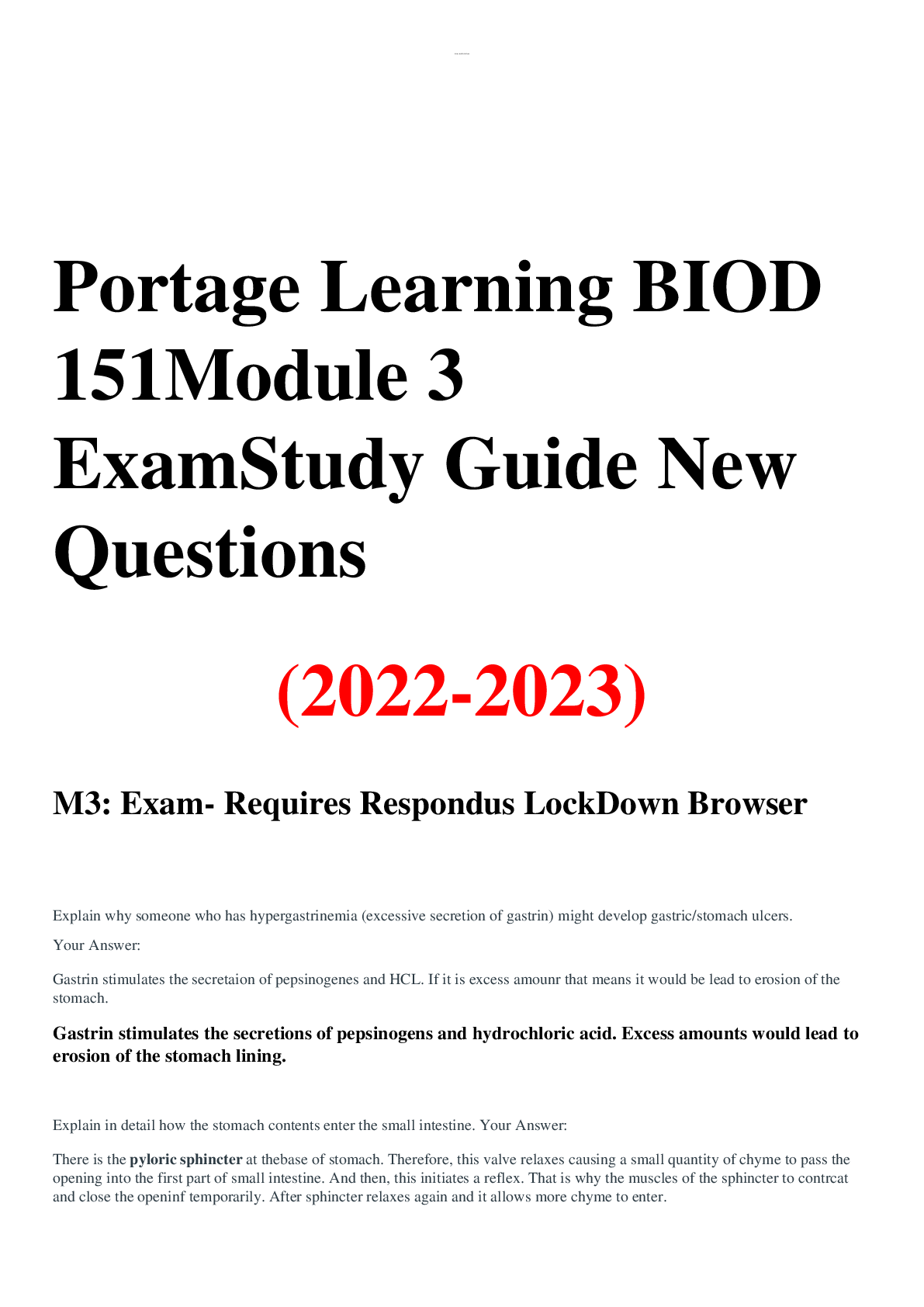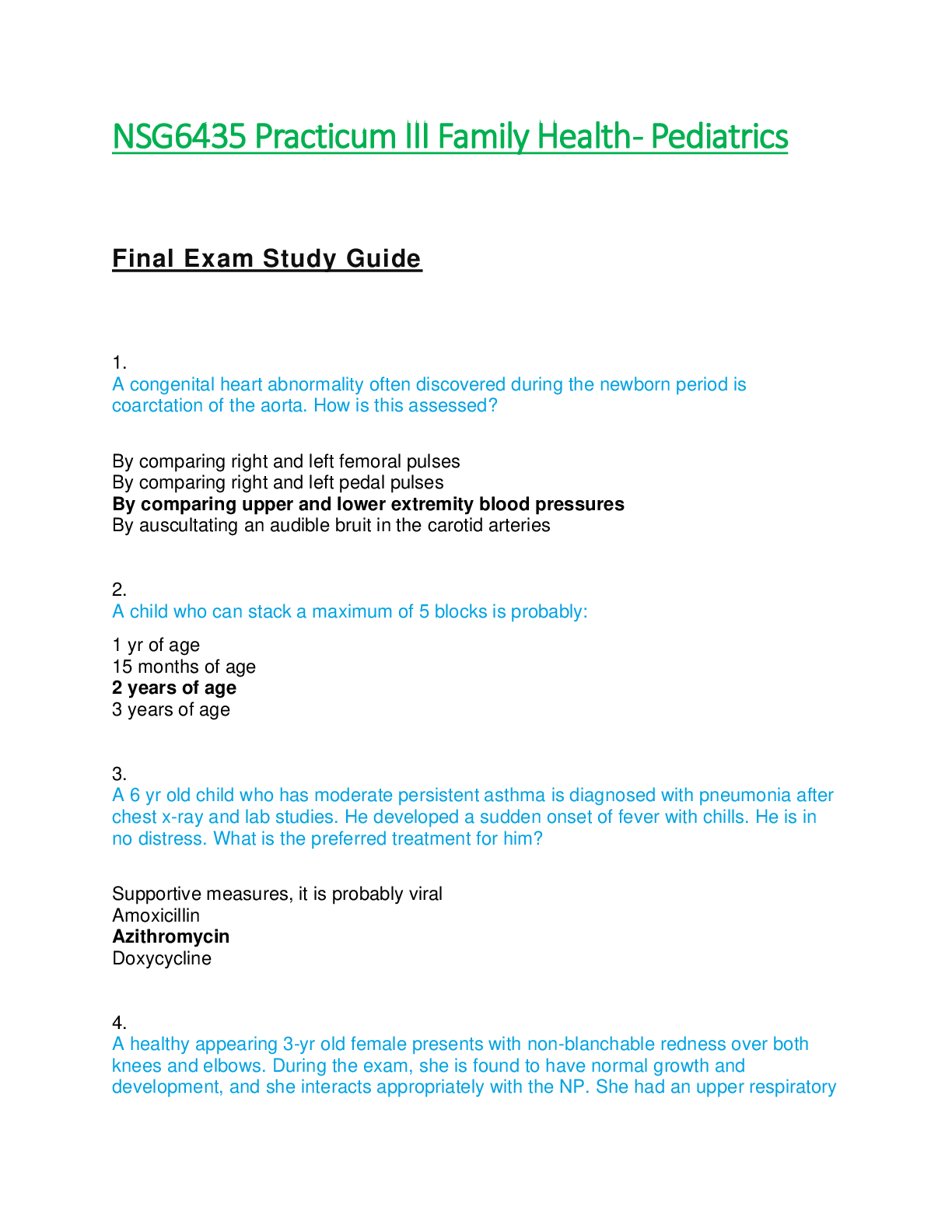UWorld MCAT EXAM STUDY GUIDE ANSWERED 100%
Document Content and Description Below
folkways - ANSWER less formal social norms that, when violated (eg, wearing clothes backward), typically result in informal sanctions (eg, raised eyebrows). societal mores - ANSWER widely observed ... social norms violating them can result in arrest taboo - ANSWER deviant behaviors considered morally reprehensible by society. Committing a taboo often results in a formal sanction, the application of an institutional response, such as arrest or incarceration. prejudice vs discrimination - ANSWER refers to preconceived ideas and beliefs about people or groups based on their group membership. Discrimination is the unequal treatment of individuals or groups on the basis of group membership. master status - ANSWER is the one that dominates in social situations. A master status can be either ascribed or achieved, may be context-dependent, and tends to influence most aspects of one's social life. intersectionality - ANSWER describes how all individuals hold multiple, interconnected identities that simultaneously impact their lives and perspectives. For example, being female is not the only identity that affects how a woman sees, experiences, or is treated in the world. Her experiences and perspectives are also a product of her other identities (eg, race/ethnicity, class, sexual orientation). labeling theory - ANSWER suggests that when someone is labeled as deviant, the act of being labeled produces further deviance. The initial act is called primary deviance and, if labeled, results in social stigma such as disapproval by others. Internalization of the deviant label leads to further acts of deviance, called secondary deviance. reduced need for sleep is a symptom of - ANSWER a symptom of mania, which is also characterized by increased energy or agitation, flight of ideas (rapid thoughts), feelings of grandiosity, distractibility, and/or impulsive or reckless behaviors. Mania is indicative of bipolar disorder (not psychosis or schizophrenia), positive symptoms of schizophrenia - ANSWER "pathological excesses" (eg, hallucinations, delusions, disorganized speech, disorganized behavior), negative symptoms of schizophrenia - ANSWER "pathological deficits" (eg, apathy, inability to experience pleasure what other type of symptoms do ppl with schizophrenia usually experience - ANSWER psychomotor symptoms (ie, changes in muscle tone or activity), which can occur either as a symptom of schizophrenia or as a side effect of medication. internal validity - ANSWER refers to the extent to which a measure or experiment produces a true result (causality) external validity - ANSWER also known as generalizability, is the extent to which study results can be applied outside the laboratory to real-life situations. social loafing - ANSWER occurs when an individual expends less effort when working as part of a group than when working alone (eg, people tend to clap less loudly as part of a group than when no one else is clapping). role strain vs role conflict - ANSWER strain -> one role, many requirements conflict -> many different roles structural functionalism - ANSWER is a macro-level (large-scale) sociological perspective that compares modern society to a biological organism. This theory proposes that as the various organ systems cooperate to maintain an organism's homeostasis, social institutions work together in the interest of societal balance, known as dynamic equilibrium. From the structural functionalist perspective, social institutions have manifest functions, which are expected, and latent functions, which are unintended. For example, the higher education system is meant to teach students the skills necessary to become functioning citizens in society (eg, manifest function), but many students also end up meeting potential romantic partners in college (eg, latent function). exchange-rational choice - ANSWER refers to two micro-level (small-scale) sociological perspectives. Social exchange theory proposes that interactions between people are based on each person's calculation of benefits and costs; rational choice theory proposes that humans make rational decisions to maximize gain and minimize loss. The passage describes large-scale social changes, not small-scale interactions or individual decisions. symbolic interactionism - ANSWER a micro-level (small-scale) sociological perspective, is concerned with person-to-person interactions using symbols (eg, language, signs, objects/behaviors that have subjective meaning). The passage describes large-scale social changes, not small-scale interactions instinctive drift - ANSWER describes an animal's innate behaviors overshadowing a learned behavior. Animals can often be trained using operant conditioning, whereby a desired behavior is reinforced with a reward. However, even when reinforcement is provided, trained animals will often revert to innate behaviors. learned perspective of language acquisition - ANSWER Learned via: Operant conditioning Language imitation & practice nativist perspective of language acquisition - ANSWER Innate & biologically predetermined Occurs during a critical (time-sensitive)period early in life interactionist perspective of language acquisition - ANSWER Biological (due to normal brain development) AND Social (due to interaction, reinforcement,desire/motivation to communicate) secularization - ANSWER Reduced power of religion as religious involvement declines religiosity vs religious affiliation - ANSWER refers to the extent to which a religious doctrine is internalized and incorporated into an individual's life (eg, behaviors, beliefs). For example, Jewish individuals with a high degree of religiosity demonstrate many beliefs and behaviors that align with Judaism, and "being Jewish" is an important part of how they define themselves. Religious affiliation describes the specific religious group to which an individual identifies, which is not synonymous with living one's life according to the principles, behaviors, or customs of that religion. For example, one may consider oneself to be Catholic but not attend church. A study in which believers are surveyed about the incorporation of religion into their lives is assessing religiosity, not religious affiliation. power vs authority - ANSWER In sociology, power refers to the ability to control and influence others. Authority refers to whether others believe that the power is legitimate. There are three types of authority: 3 types of authority-traditional, charismatic, and rational-legal - ANSWER Traditional authority comes from longstanding patterns in society (eg, a queen is seen as having legitimate power in a monarchy). Charismatic authority stems from the personal appeal and/or extraordinary claims of an individual (eg, Gandhi was seen as having legitimate power due to his ability to inspire people). Rational-legal authority arises from the professional position a person holds (eg, a physician is seen as having legitimate power due to extensive training). positive punishment - ANSWER undesirable stimulus is added negative punishment - ANSWER desirable stimulus is removed positive reinforcement - ANSWER desirable stimulus added negative reinforcement - ANSWER undesirable stimulus removed escape learning - ANSWER negative reinforcement occurs when an individual learns how to terminate a current unpleasant stimulus. For example, an antiemetic that treats current PN may produce escape learning, as the individual learns that taking the medication stops N/V (unpleasant stimulus). avoidance learning - ANSWER negative reinforcement occurs when an individual figures out how to prevent experiencing the unpleasant stimulus in the future. For example, taking an antiemetic before chemotherapy, thereby preventing a recurrence of N/V (unpleasant stimulus), is an example of avoidance learning. asquisition - ANSWER refers to the learning that takes place as an association is formed between the unconditioned stimulus (eg, food) and the neutral stimulus (eg, bell). humanistic therapy - ANSWER person centered attempts to empower individual to move toward self actualiation unconditional postivie regard and empathy used to encourage client to reach full potential cognitive-behavioral therapy - ANSWER attempts to chagne negative thoguhts/beliefs and maladaptive bheaviors. techniques like desensitization, self-talk to replace destructive thoughts/behaviors w healthy ones primary vs secondary appraisal - ANSWER In a primary appraisal, an individual classifies a stimulus as threatening, positive, or irrelevant. For stimuli deemed threatening, a secondary appraisal takes place in which the individual evaluates whether their resources/abilities are sufficient to cope with the stressor. appraisal - ANSWER (evaluation) of a stimulus determines one's emotional response central (foveal) vision - ANSWER peripheral vision - ANSWER Rods, present primarily in the periphery of the retina, are much more sensitive to light than cones. Rods do not transmit information about color but are well suited to detect motion and low-intensity (dim) light, producing high visual sensitivity. flashbulb memory - ANSWER are vivid, detailed autobiographical memories of an event that was extremely emotional or distinct or personally significant. Flashbulb memories may be best defined by the degree to which individuals feel confident about their recollections, even when the recollections are not completely accurate or consistent over time. conditioning is often the result of what kind of memory - ANSWER Classically conditioned fear responses are emotional, outside of conscious recall (ie, automatic/involuntary), and often elicit reflexive responses (eg, startle reflex). Therefore, the conditioned fear response during phase 2 occurs as a result of implicit memory. george herbert mead - ANSWER who is most associated with the sociological theory of symbolic interactionism, argued that social (rather than biological) factors influence identity formation. Mead suggested that the experience of "self" emerges through social interaction with others who play important and formative roles in one's life (eg, family). The two aspects of the self are the "I" and "me," which develop in stages: preparatory stage - ANSWER (or imitation): Babies/toddlers imitate others (eg, a parent's hand gesture) and begin using symbols and language (eg, repeating a phrase used by a parent) without meaning comprehension. At this stage, children have no sense of "self" as separate from the world around them. play stage - ANSWER Through play (eg, pretending to be a doctor), preschool-age children begin role-taking (ie, understanding the perspectives of others). When children understand themselves as individuals separate from others, the "I" component of the self has developed. Children then begin to imagine how others perceive them, which is the beginning of the development of the "me." game stage - ANSWER School-age children become aware of their position/role in relation to others. They begin to see themselves from the perspective of the more abstract generalized other, further developing the "me" to incorporate the values and rules of the society in which they live. absolute threshold - ANSWER is the intensity value at which an individual is able to detect the stimulus 50% of the time. progesterone - ANSWER rise substantially following ovulation. This progesterone is secreted by the corpus luteum (the portion of the ovarian follicle remaining in the ovary following ovulation) and maintains the uterine lining, which at this point in the cycle has thickened in preparation for the implantation of an embryo. If pregnancy does not occur, the corpus luteum degenerates and progesterone levels fall as a new cycle begins. what does secretion of estrogen and progesterone promote during puberty - ANSWER -growth and maturation of female sex organs -development of sex-specific traits (best development, widening of pelvis) -initiation of menstrual cycle thru stimulation of oogenesis and ovultion surgical removal of ovaries in women of reproductive age causes waht - ANSWER mimics withdrawal of female sex hormones normally associated with menopause (age 50) menopause - ANSWER production of estrogen and progesterone in ovaries declines substantially leading to -vaginal epithelium dehydrates causing discomfort and impariing sexual acitivity -chagnes in mood like irritability and depression -reproductive organs and breasts shrink (atrophy) endometrial implants in vagina - ANSWER the sexual organ through which sperm enters the uterus. Endometrial implants within the vagina may impair the passage of sperm and decrease the likelihood that an ovulated oocyte will be fertilize ovaries with endometrial implants - ANSWER the female gonads that produce gametes (oocytes) and secrete female sex hormones. Endometrial implants attached to the ovary may cause infertility by impairing follicular maturation or ovulation, the release of an oocyte (egg cell) endometrial implants in fallopian tubes - ANSWER duct structures lined with motile cilia that transfer the ovulated oocyte from the abdominal cavity toward the uterus; also the primary site of fertilization. Endometrial implants that block or impair the function of the fallopian tubes would prevent a fertilized oocyte from reaching the uterus for implantation endometrial implants in cervix - ANSWER the barrier separating the vagina and uterus. Endometrial implants that block the cervical canal may impair the passage of sperm and decrease the likelihood of fertilization. how does vasal dilation affect dehydration - ANSWER Vasodilation of renal blood vessels increases blood flow to the kidney and consequently increases the glomerular filtration rate (amount of blood filtered per unit time). This leads to increased urine output and decreased blood volume, worsening dehydration. innate immune system - ANSWER skin and mucous membranes and specialized proteins and cells that rapidly and nonspecifically recognize and destory antigens neutral theory of molecule evolution - ANSWER the majority of genetic mutations are neutral, which means that they do not affect the fitness of an organism. These neutral mutations are randomly fixed or lost due to genetic drift and occur at a fairly constant rate over time and across different species. After two species diverge (separate), the accumulation rate of neutral mutations in a region of homologous DNA is mostly similar in both species. Accordingly, this "molecular clock" of evolution is said to be linear because the number of neutral mutations generally increases with time. kindey divisions - ANSWER outer cortex and inner 'salty' medulla glomerular capillaries in the ____ do what? - ANSWER in the cortex filter blood into bowman's capsule what happens to filtrate after bowmans capsule - ANSWER moves through proximal tubes and flows into loop of henle purpose of loop of henle - ANSWER reabsorbs what and salt countercurrent multiplication - ANSWER forms a concentration gradient within loop of Henl that maximizes water reabsorption descending limb of loop of henle - ANSWER extends from cortex into the slaty medulla highly permable to water impermeable to NaCl so filtrate becomes more concentrated, water passivley reabosrbed via osmosis into medulla, where it is taken up by blood vessels ascending limb of henle - ANSWER travels from medulla back to cortex impermeable to water permeable to NaCl NaCl first passively reabosrbedi nto medulla as it nears cortex, NaCl is actively transported out of filtrate and into medulla this maintain's medulla's hgih slat concentraition what blood vessels does water and NaCl move into from loop of Henle - ANSWER vasa recta blood flow through circulatory system dictated by - ANSWER blood pressure (hydrostatic) vascular resistence cardiac output cardiac output dependent on - ANSWER stroke rate and stroke volume what would reduced ventricular filling do to vascular resistance - ANSWER less blood, decreased CO cardiac output, and decreased cardiac output increases vascular resistance depolarization in the heart - ANSWER there are specialized clusters of self-depolarizing cells in upper atrial wall and lower interatrial septum -depolarization occurs via influx of positive ions (Na+, Ca2+) into SA and AV nodal cells, increasing cell membrane potentials nad generating action potentials -APs fired travel thru cardiac muscle cells of atrria, inducing atrial contraction and filling of ventricles -at AV node, relay of APs to ventricular cells is delayed so ventricles can be filled before ventricular contractions -then APs travel through both ventricles, so they contract and expel blood into arteries what happens to blood pH in a pt with decreased pulmonary exchange - ANSWER The patient is found to have decreased pulmonary gas exchange, indicating that O2 uptake into the blood and CO2 removal from the blood at the lungs is decreased. If left untreated, this condition will lead to low O2 and high CO2 levels in the patient's blood. This will shift the equilibrium of the reaction described above to the right, increasing the production of H2CO3, which in turn will dissociate, thereby increasing the presence of both HCO3− and H+ ions in the blood. Increased levels of circulating free H+ ions will lead to decreased blood pH, a phenomenon known as respiratory acidosis how many bp are in a plasmid once a gene is inserted - ANSWER original plasmic--restriction sites cut out + vector gene inserted formation of cDNA - ANSWER the enzyme reverse transcriptase produces a single-stranded DNA molecule using mRNA as a template. The cDNA strand is complementary to the mRNA and therefore is complementary to the sense strand of the genomic DNA (ie, cDNA is an antisense strand). how is a gene of interest in a plasmid usually made, what makes its expression different from endogenous gene expression - ANSWER it's usually made from reverse transcriptase producing cDNA from mRNA so this means there will be no splicing in its production since the mRNA from which it was produced was already spliced oogenesis - ANSWER process by which females produce sex cells (gametes) called eggs what cell cycle are oocytes in when a girl si born - ANSWER arrested in prophase I (called primary oocytes) what happesn to oocytes at puberty - ANSWER each month a single primary oocyte develops into a secondary oocyte by continuing meiosis up to metaphase II follicular phase of cycle - ANSWER follicle (oocyte + supporting granulosa cells) matures until it bulges at outer wall of ovary matural and growth of follicle is driven by release of folicle-stimulating hormone (FSH) from the anterior pituitary luteinizing hormone (LH) stimulates follicle rupture and release of secondary oocyte near opening of the fallopian tube (ovulation) FSH - ANSWER stimulates maturation and growth of the follicle from anterior pituitary LH - ANSWER stimulates follicle rupture and release of secondary oocyte near opening of fallopian tube (ovulation) fertilization becomes possible - ANSWER after released secondary oocyte has been drawn into fallopian tube [Show More]
Last updated: 1 year ago
Preview 1 out of 92 pages
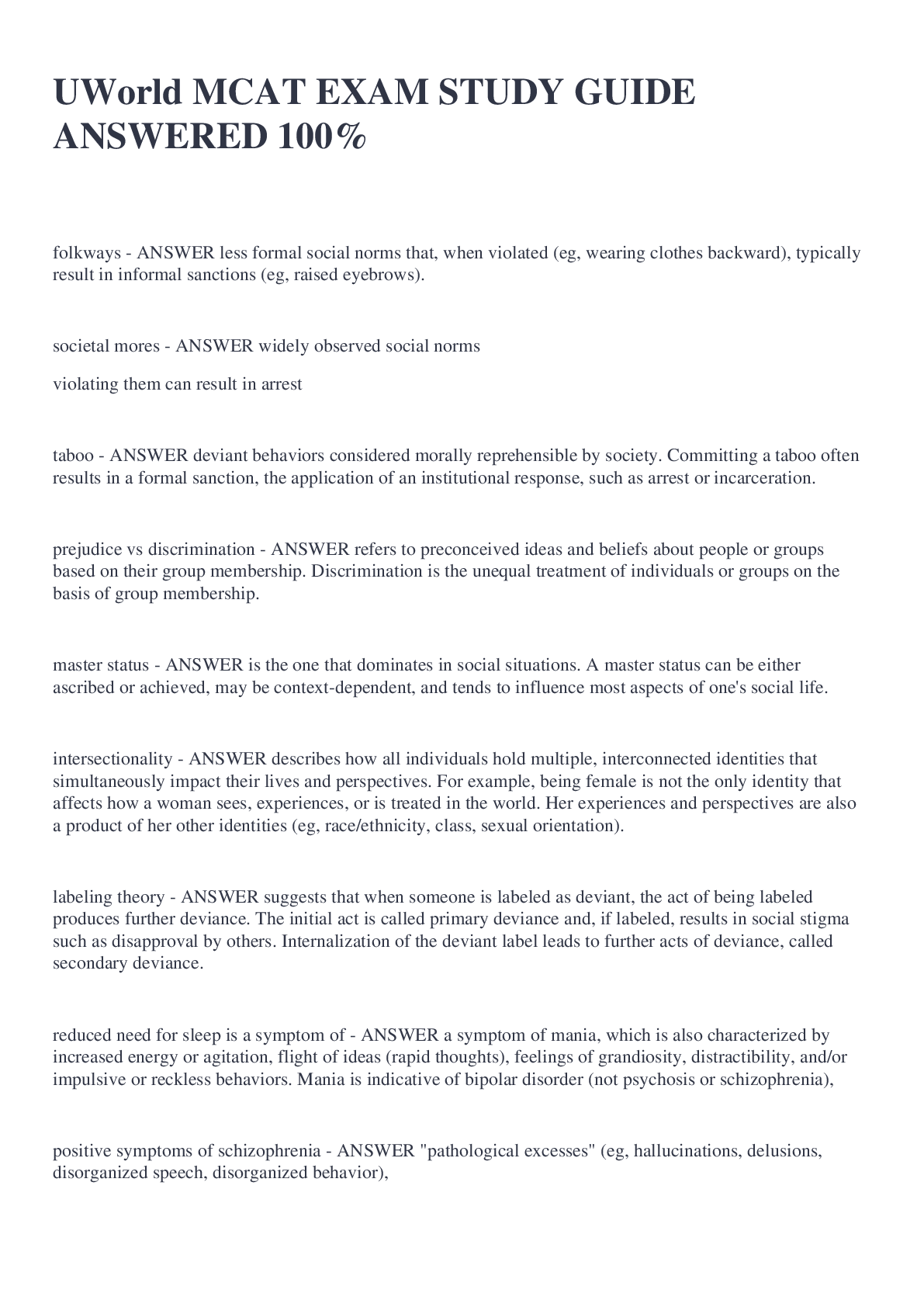
Reviews( 0 )
Document information
Connected school, study & course
About the document
Uploaded On
Nov 19, 2022
Number of pages
92
Written in
Additional information
This document has been written for:
Uploaded
Nov 19, 2022
Downloads
0
Views
28

